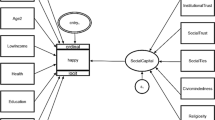Abstract
The aim of this study is to construct a causal relationship model explaining the relationships between social policy factors and national competitiveness and national happiness; and to analyse how the former affect the latter as final dependent variables. In doing this, the study employs data for OECD member countries. Research regarding the determinants affecting national competitiveness and people’s happiness has tended to focus mainly on personal or collective characteristics such as age, gender, economic infrastructure, etc. As a result, social policy factors, including welfare budget, unemployment support budget and income inequality, have rarely been addressed in the analysis of determinants affecting national competitiveness or happiness, which is regarded as the final policy aim to be achieved by government. In particular, there has been little academic research utilizing OECD database statistics on social policy indicators. Against this background, this study uses the Structural Equation Modeling approach (SEM) to identify the direct and indirect effects of social policy factors on national competitiveness and happiness, and puts forward policy suggestions for attaining these two great goals of social policy.


Similar content being viewed by others
Notes
These indicators include 14 main categories: income, consumption, employment, welfare, housing, subjective well-being, health, family, community, culture, leisure, citizen participation, safety, and environment.
References
Bjørnskov, C., Drehe, A., & Fischer, J. (2008). On decentralization and life satisfaction. Economics Letters, 99, 147–151.
Choi, M. O. and Moon, Y. S. (2011). Analysis of happiness determinants in Busan residents. Local Government Studies Review, 15(1), 277–297.
Cakar, F., & Karatas, Z. (2012). The self-esteem, perceived social support and hopelessness in adolescents: the structural equation modeling. Educational Sciences: Theory and Practice, 12(4), 2,406–2,412.
Choi, Y. C. (2008). Relationships between national competitiveness and decentralization. Korean Association of Local Government Studies Summer Conference Proceedings.
Easterlin, R. (1974). Does economic growth improve the human lot? Some empirical evidence. In P. A. David, & M. W. Reder (Eds.), Nations and households in economic growth. New York: Academic Press.
Fukasaku, K., & de Mello, L. (1998). Fiscal decentralization and macroeconomic stability: the experience of large developing countries and transition economies in democracy. In K. Fukasaku, & R. Hausmann (Eds.), Decentralization and deficits in Latin America. Paris: Development Centre of the OECD.
Gao, S., Mokhtarian, P., & Johnston, R. (2008). Exploring the connections among job accessibility, employment, income, and auto ownership using structural equation modeling. The Annals of Regional Science, 42, 341–356.
Greve, B. (2010). Happiness and social policy in Europe. Northampton: Edward Edgar.
Ha, H. S. (1996). Analysis of determinants affecting quality of life in urban government. Korean Public Administration Review, 30(2), 81–95.
Han, P. H. (1995). Development of Urban Indicators and their Application. KRILA report. Seoul: KRILA.
Hayduck, L. A. (1987). Structural Equation Modeling with LISREL: Essentials and advances. Baltimore, MD: Johns Hopkins.
Helliwell, J.F. and Putnam, R.D. (1995). Education and social capital. Eastern Economic Journal, 33(1), 1–19.
Helliwell, J. F. (2001). Social capital, the economy and well-being. Canada: The Review of Economic Progress.
Helliwell, J.F. and Putnam, R.D. (2005). The social context of well-being in the The Science of Well-Being, edited by F.A. Huppert, N. Baylis and B. Keverne. Oxford: Oxford University Press.
Helliwell, J. F. (2006). Well-being, social capital and public policy: what’s new? The Econometrics Journal, 116(March), C34–C45.
Holzinger, K., & Knill, C. (2008). Theoretical framework: causal factors and convergence expectations. In K. Holzinger, C. Knill, & B. Arts (Eds.), Environmental Policy Convergence in Europe: The impact of international institutions and trade. Cambridge: Cambridge University Press.
IMD (2013). World competitiveness yearbook. Lausanne: IMD.
Lee, J. H. (2010). Relationships between teachers’ psychological exhaustion and their subjective well-being. Korean Teachers’ Education Review, 27(3), 143–164.
Lee, T. J., Park, C. M., & Song, K. S. (2005). Analysis of quality of life of local residents. Korean Local Government Review, 12(4), 75–92.
Lim, H. S. (1996). Conceptual discussions on quality of life. Korean Publ Administration Review, 5(1), 5–18.
Kim, S. K., Jang, Y. S., Cho, H. S., & Cha, M. S. (2008). Happiness Index and Happiness Determinants. Korea health and society research institute report. Seoul: KHSR.
Mogilner, C., Aaker, J., & Kamvar, S. (2011). How happiness affects choice. Journal of Consumer Research, 39, 429–443.
OECD (2013). How is life in your region? Paris: OECD.
Seligman, E. P. (2004). Can happiness be taught? Daedalus.
Soh, J. K. (1998). Definition of quality of life and its policy implications for urban policy. Regional Community Development Review, 23(1), 65–84.
Stiglitz-Sen-Fitoussi. (2009). Report of the Commission on the Measurement of Economic Performance and Social Progress. www.stiglitz-sen-fitoussi.fr.
Tanzi, V., & Schuknecht, L. (1998). Can small governments secure economic and social well Being? In H. Grubel (Ed.), How To Spend the Fiscal Dividend: What is the optimal size of government?. Fraser Institute: Vancouver.
UN (2013). World Happiness Report 2013. New York: UN.
World Economic Forum (2008). Global competitiveness report. Geneva: WEF.
World Value Survey (2013). World Value Survey Database.
Wren-Lewis, S. (2014). How successfully can we measure well-being through measuring happiness? South Africa Journal of Philosophy, 33(4), 417–432.
Xie, D., Zou, H. and Davoodi, H. (1999). Fiscal decentralization and economic growth in the United States. Journal of Urban Economics, 45, 228–239.
Zhang, T., & Zou, H. (1998). Fiscal decentralization, public spending and economic growth in China. Journal of Public Economics, 67(2), 221–240 http://www.businessdictionary.com/definition/competitiveness.html#ixzz30zQkwt00.
Acknowledgments
This work was supported by the National Research Foundation of Korea Grant funded by the Korean Government (KRF-2013S1A3A2054622).
Author information
Authors and Affiliations
Corresponding author
Rights and permissions
About this article
Cite this article
Choi, YC., Jang, JH. Relationships Among Social Policy Factors, National Competitiveness, and Happiness. Applied Research Quality Life 11, 1189–1205 (2016). https://doi.org/10.1007/s11482-015-9429-4
Received:
Accepted:
Published:
Issue Date:
DOI: https://doi.org/10.1007/s11482-015-9429-4




